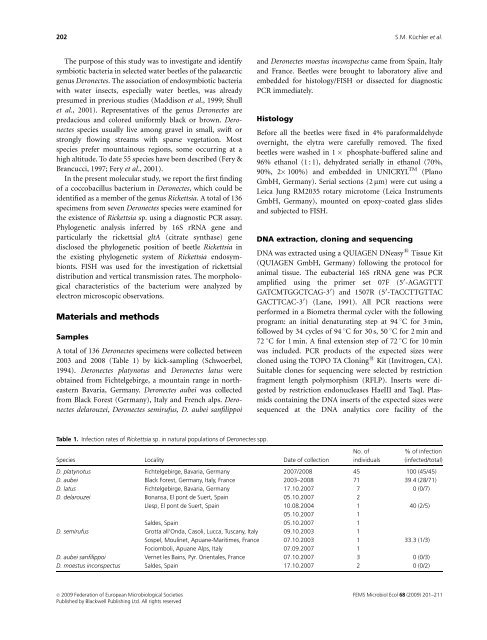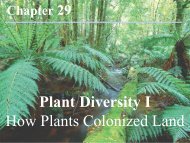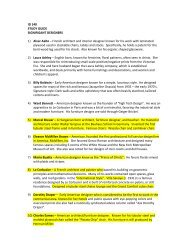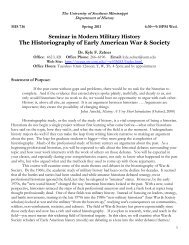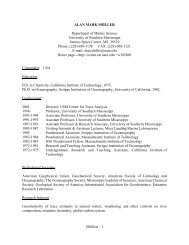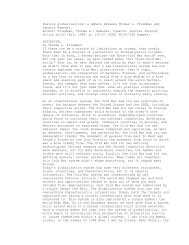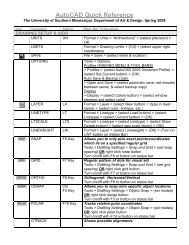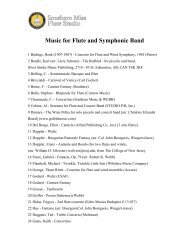Get PDF (1214K) - Wiley Online Library
Get PDF (1214K) - Wiley Online Library
Get PDF (1214K) - Wiley Online Library
Create successful ePaper yourself
Turn your PDF publications into a flip-book with our unique Google optimized e-Paper software.
202 S.M. Küchler et al.<br />
The purpose of this study was to investigate and identify<br />
symbiotic bacteria in selected water beetles of the palaearctic<br />
genus Deronectes. The association of endosymbiotic bacteria<br />
with water insects, especially water beetles, was already<br />
presumed in previous studies (Maddison et al., 1999; Shull<br />
et al., 2001). Representatives of the genus Deronectes are<br />
predacious and colored uniformly black or brown. Deronectes<br />
species usually live among gravel in small, swift or<br />
strongly flowing streams with sparse vegetation. Most<br />
species prefer mountainous regions, some occurring at a<br />
high altitude. To date 55 species have been described (Fery &<br />
Brancucci, 1997; Fery et al., 2001).<br />
In the present molecular study, we report the first finding<br />
of a coccobacillus bacterium in Deronectes, which could be<br />
identified as a member of the genus Rickettsia. A total of 136<br />
specimens from seven Deronectes species were examined for<br />
the existence of Rickettsia sp. using a diagnostic PCR assay.<br />
Phylogenetic analysis inferred by 16S rRNA gene and<br />
particularly the rickettsial gltA (citrate synthase) gene<br />
disclosed the phylogenetic position of beetle Rickettsia in<br />
the existing phylogenetic system of Rickettsia endosymbionts.<br />
FISH was used for the investigation of rickettsial<br />
distribution and vertical transmission rates. The morphological<br />
characteristics of the bacterium were analyzed by<br />
electron microscopic observations.<br />
Materials and methods<br />
Samples<br />
A total of 136 Deronectes specimens were collected between<br />
2003 and 2008 (Table 1) by kick-sampling (Schwoerbel,<br />
1994). Deronectes platynotus and Deronectes latus were<br />
obtained from Fichtelgebirge, a mountain range in northeastern<br />
Bavaria, Germany. Deronectes aubei was collected<br />
from Black Forest (Germany), Italy and French alps. Deronectes<br />
delarouzei, Deronectes semirufus, D. aubei sanfilippoi<br />
and Deronectes moestus inconspectus came from Spain, Italy<br />
and France. Beetles were brought to laboratory alive and<br />
embedded for histology/FISH or dissected for diagnostic<br />
PCR immediately.<br />
Histology<br />
Before all the beetles were fixed in 4% paraformaldehyde<br />
overnight, the elytra were carefully removed. The fixed<br />
beetles were washed in 1 phosphate-buffered saline and<br />
96% ethanol (1 : 1), dehydrated serially in ethanol (70%,<br />
90%, 2 100%) and embedded in UNICRYL TM (Plano<br />
GmbH, Germany). Serial sections (2 mm) were cut using a<br />
Leica Jung RM2035 rotary microtome (Leica Instruments<br />
GmbH, Germany), mounted on epoxy-coated glass slides<br />
and subjected to FISH.<br />
DNA extraction, cloning and sequencing<br />
DNA was extracted using a QUIAGEN DNeasy s Tissue Kit<br />
(QUIAGEN GmbH, Germany) following the protocol for<br />
animal tissue. The eubacterial 16S rRNA gene was PCR<br />
amplified using the primer set 07F (5 0 -AGAGTTT<br />
GATCMTGGCTCAG-3 0 ) and 1507R (5 0 -TACCTTGTTAC<br />
GACTTCAC-3 0 ) (Lane, 1991). All PCR reactions were<br />
performed in a Biometra thermal cycler with the following<br />
program: an initial denaturating step at 94 1C for 3 min,<br />
followed by 34 cycles of 94 1C for 30 s, 50 1C for 2 min and<br />
72 1C for 1 min. A final extension step of 72 1C for 10 min<br />
was included. PCR products of the expected sizes were<br />
cloned using the TOPO TA Cloning s Kit (Invitrogen, CA).<br />
Suitable clones for sequencing were selected by restriction<br />
fragment length polymorphism (RFLP). Inserts were digested<br />
by restriction endonucleases HaeIII and TaqI. Plasmids<br />
containing the DNA inserts of the expected sizes were<br />
sequenced at the DNA analytics core facility of the<br />
Table 1. Infection rates of Rickettsia sp. in natural populations of Deronectes spp.<br />
Species Locality Date of collection<br />
No. of<br />
individuals<br />
% of infection<br />
(infected/total)<br />
D. platynotus Fichtelgebirge, Bavaria, Germany 2007/2008 45 100 (45/45)<br />
D. aubei Black Forest, Germany, Italy, France 2003–2008 71 39.4 (28/71)<br />
D. latus Fichtelgebirge, Bavaria, Germany 17.10.2007 7 0 (0/7)<br />
D. delarouzei Bonansa, El pont de Suert, Spain 05.10.2007 2<br />
Llesp, El pont de Suert, Spain 10.08.2004 1 40 (2/5)<br />
05.10.2007 1<br />
Saldes, Spain 05.10.2007 1<br />
D. semirufus Grotta all’Onda, Casoli, Lucca, Tuscany, Italy 09.10.2003 1<br />
Sospel, Moulinet, Apuane-Maritimes, France 07.10.2003 1 33.3 (1/3)<br />
Fociomboli, Apuane Alps, Italy 07.09.2007 1<br />
D. aubei sanfilippoi Vernet les Bains, Pyr. Orientales, France 07.10.2007 3 0 (0/3)<br />
D. moestus inconspectus Saldes, Spain 17.10.2007 2 0 (0/2)<br />
c 2009 Federation of European Microbiological Societies<br />
Published by Blackwell Publishing Ltd. All rights reserved<br />
FEMS Microbiol Ecol 68 (2009) 201–211


